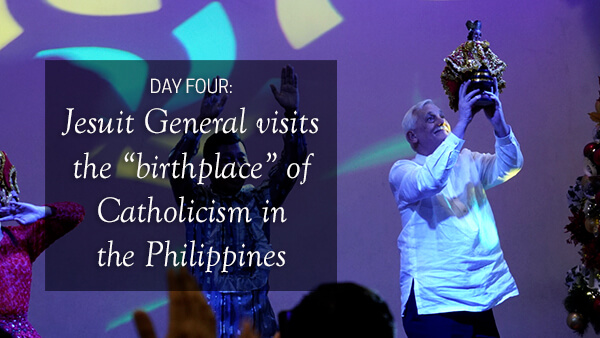
December 12, 2018
Father General Arturo Sosa, SJ landed at the Mactan Airport, Cebu on board Philippine Airlines PR 2853 at 1:41 PM, yesterday, Tuesday, December 11, 2018. He was met by Jesuits and representatives of Sacred Heart School-Ateneo de Cebu, the eminent Jesuit school in the city. He was then brought to the Basilica Minore del Santo Niño de Cebu for the first program of the day.
The said basilica is under the Augustinians, who, in 1565, constructed a church of bamboo, wood and thatch to house the iconic image of Christ as Child-King, who holds an orb and a scepter in his hands. Discovered by the occupying troops of Miguel Lopez de Legazpi in April of that same year, it is believed to be the same image that Ferdinand Magellan gave to the wife of a local chieftain, Rajah Humabon in March 1521. Seen as a portent of divine favor, the image was turned over to the Augustinians who over time replaced the thatched church with one of stone. The present church is traced to the year 1711 and is the work of the Augustinian Juan de Albarran. The church suffered damage over the years but was restored again and again.
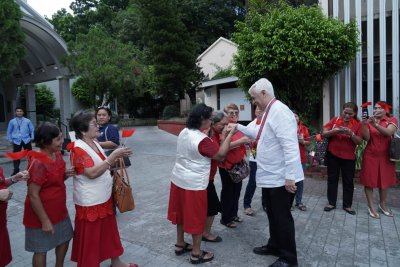 This short visit is especially significant because the Church in the Philippines is preparing for 2021, the 500th year anniversary of the arrival of Magellan and the first celebrations of the Eucharist and Baptism in the Philippines.
This short visit is especially significant because the Church in the Philippines is preparing for 2021, the 500th year anniversary of the arrival of Magellan and the first celebrations of the Eucharist and Baptism in the Philippines.
Fr. Sosa was greeted at the door of the basilica by Fr. Pacifico C. Nohara, Jr, the Augustinian prior and rector of the basilica, who brought the party to the chapel of the Santo Niño for a short moment of prayer. Then, he led the party to the upper floor to show the grand hall and the library. He spoke of the paintings of Augustinian saints in the basilica and of Pedro Agurto, who was the first bishop of Cebu. Agurto was instrumental in bringing the Jesuits to Cebu in 1595, the same year the diocese of Cebu was established.
After a brief visit to Magellan’s cross, and prayer at the basilica, Fr. Sosa proceeded to the Archdiocesan Shrine of the Sacred Heart to meet with the Chinese-Filipino Catholics and other parishioners of this personal and territorial parish established in 1952 by the Jesuits who had left China during the Communist takeover. They sought refuge in the Philippines, finding welcome in Manila, Baguio, Cebu and Iloilo.
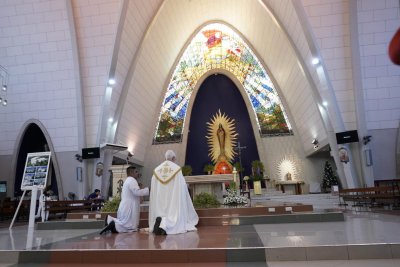 In a two-part liturgical ceremony, Fr. Sosa was welcomed by the shrine rector and parish priest, Fr. Vidal Gornez, who gave a brief history of the parish and introduced the groups in the shrine church, such as the members of the pastoral council, the Apostleship of Prayer, other mandated organizations of the parish, and me ofmbers religious congregations, especially the Religious of the Virgin Mary, who are Ignatian in their spirituality and run retreat houses in the Philippines. In his response, Fr. Sosa spoke of the centrality of Jesus in the Christian life and the potent symbol of the Sacred Heart. Then, kneeling in front of the altar with Fr. Gornez and Fr. Manny Uy, director of SHS-AdC, he led the community in a consecration to the heart of Jesus.
In a two-part liturgical ceremony, Fr. Sosa was welcomed by the shrine rector and parish priest, Fr. Vidal Gornez, who gave a brief history of the parish and introduced the groups in the shrine church, such as the members of the pastoral council, the Apostleship of Prayer, other mandated organizations of the parish, and me ofmbers religious congregations, especially the Religious of the Virgin Mary, who are Ignatian in their spirituality and run retreat houses in the Philippines. In his response, Fr. Sosa spoke of the centrality of Jesus in the Christian life and the potent symbol of the Sacred Heart. Then, kneeling in front of the altar with Fr. Gornez and Fr. Manny Uy, director of SHS-AdC, he led the community in a consecration to the heart of Jesus.
The second part began immediately in which Fr. Sosa blessed a time capsule and the items to be encased in it that symbolized the aspirations to renovate, upgrade and expand the Jesuit Retreat House there established in 1963, which would be christened as the House of Retreats of St. Peter Faber. Among the items in the capsule were the architectural plans, prepared by Espina and Associates, a leading architectural firm in Cebu. The Espina brothers who belong to the firm were all graduates of SHS-AdC. Symbolic tokens of Christian and Jesuit heritage were also enclosed in the capsule, like water, soil, frankincense and oil from the Holy Land, the medals of Sts. Ignatius, Francis Xavier and the Madonna of della Strada. A book on the history of the Jesuits in Cebu and the Banawa Retreat House and the national and local newspaper of the day were also placed in the capsule.
Items encased in the capsule were brought by representatives of the parish community as well as the network of friends, associates and benefactors that the Jesuits had built over more than six decades.
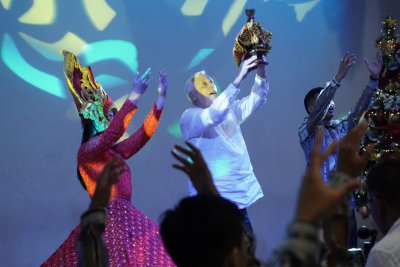 From the shrine, Fr. Sosa traveled to Canduman, Mandaue to the SHS-AdC where he spent the evening with the Jesuits and administrators and representatives of the school. He joined the Mass at the Madonna della Strada chapel, presided by Fr. Ernesto Javier, the most senior Jesuit of the SHS-AdC community. Fr. Javier stressed the appropriateness of the chapel for the event because it brought to mind St. Ignatius who was always on the move, going to wherever God willed.
From the shrine, Fr. Sosa traveled to Canduman, Mandaue to the SHS-AdC where he spent the evening with the Jesuits and administrators and representatives of the school. He joined the Mass at the Madonna della Strada chapel, presided by Fr. Ernesto Javier, the most senior Jesuit of the SHS-AdC community. Fr. Javier stressed the appropriateness of the chapel for the event because it brought to mind St. Ignatius who was always on the move, going to wherever God willed.
After Mass, those who were present crossed a corridor to enter the Pope Francis Hall for dinner. This began with a group of students and teachers leading all to a sung grace before meals. This was followed by a ritual dance to honor the Santo Niño, whose steps involve two steps forward and one step back, as if the dancer were going against a strong current, in the native language of Cebu, called sulug. Hence the dance’s name, sinulog, meaning like treading current. All were called to participate in the dance including Fr. Sosa who danced with the students and teachers while holding high the Santo Niño. The school presented him an image of the Santo Niño as a symbol of continued prayer for him and his intentions and as a reminder of his visit to Cebu. 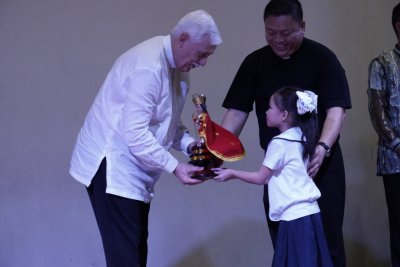
In a short address during dinner, Fr. Sosa built on the earlier homily of Fr. Javier, reminding all that St. Ignatius was a pilgrim and that he envisioned a new form of religious life, active rather than cloistered. Dinner ended shortly after eight, with the singing of the hymn “Amare et Servire.” (Report and photos courtesy of Jescom Philippines.)